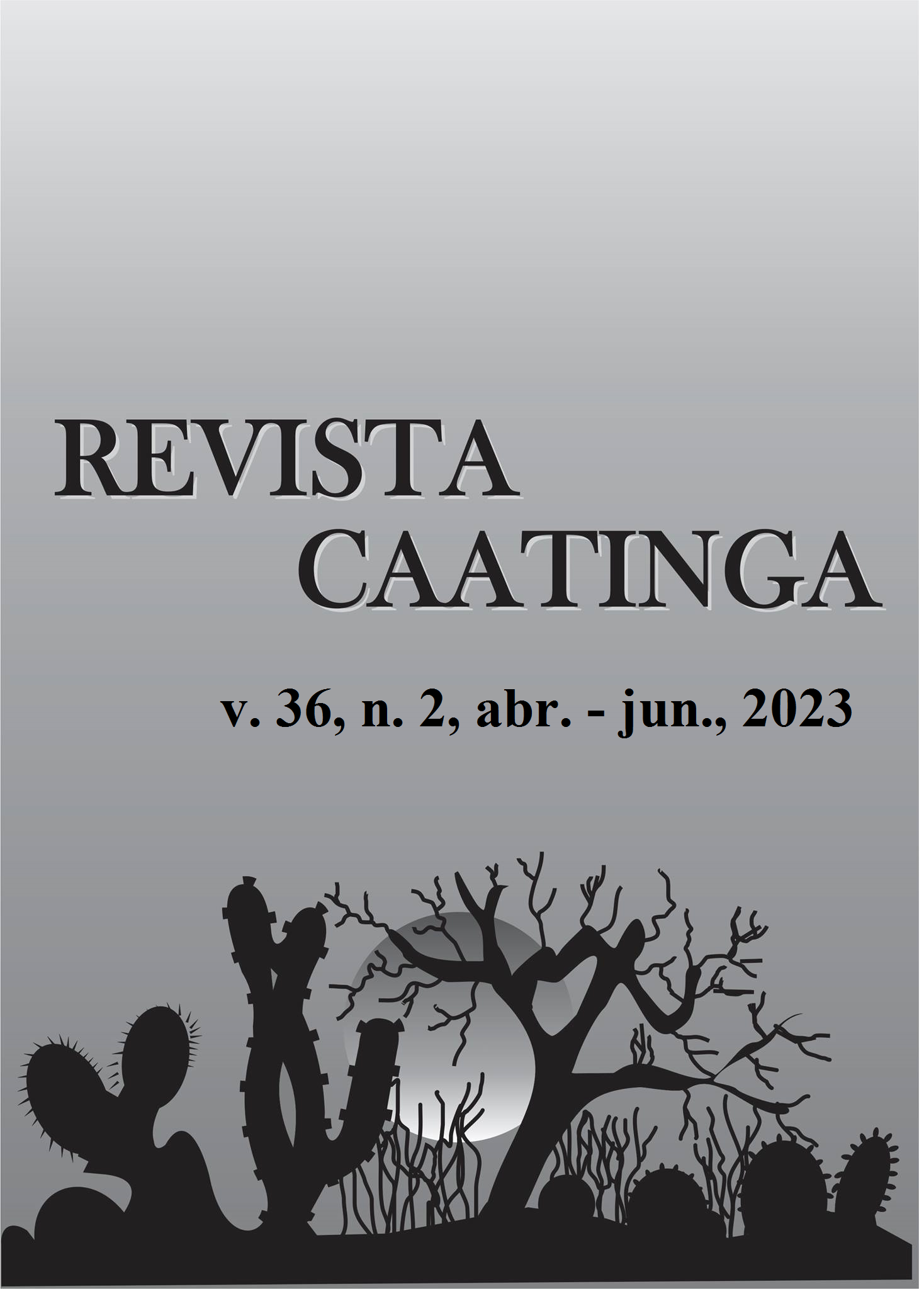Chemical attributes of an ultisol cultivated with sugarcane after application of high doses of vinasse
DOI:
https://doi.org/10.1590/1983-21252023v36n217rcKeywords:
Fertigation. Excess nutrients. Antagonism. Environment.Abstract
The use of high doses of vinasse in sugarcane crop can cause modifications in the chemical characteristics of the soil. The aim of this study was to evaluate the effect of the application of high doses of vinasse on the chemical characteristics of an Ultisol cultivated with sugarcane for 210 days. The treatments used were doses equivalent to 0 (D0), 150 (D150), 300 (D300), 600 (D600) and 1200 (D1200) m3 ha-1 of vinasse plus a control treatment with mineral fertilization. The experimental design was completely randomized with six treatments and six repetitions. Exchangeable potassium (K), calcium (Ca), magnesium (Mg) and sodium (Na) contents, organic matter, cation exchange capacity, sodium adsorption ratio, exchangeable sodium percentage, electrical conductivity and pH were analyzed at 90, 120, 150 and 210 days after planting (DAP), in addition to microbial basal respiration at 210 days at depths of 0-0.20 and 0.20-0.40 m. Soil pH increased with the use of vinasse within the proper range for sugarcane, varying from 6.2 to 6.4. The highest K and Na contents were found at D600 and D1200; the highest K and Na availability occurred at 120 DAP and 150 DAP, respectively, indicating competition between these nutrients for exchange sites. Organic matter content was proportionally high according to the vinasse dose applied. D600 and D1200 doses increased Na content in the soil, with greater magnitude at the 0-0.20 m depth.
Downloads
References
AYERS, R. S.; WESTCOT, D. W. Water quality agriculture. Roma, Food and Agriculture Organization of the United Nations, 1985. 174 p.
BENTO, L. R. et al. Release of nutrients and organic carbon in different soil types from hydrochar obtained using sugarcane bagasse and vinasse. Geoderma, 334: 24-32, 2019.
CABRAL FILHO, F. R. et al. Sugarcane vinasse cations dynamics in Cerrado Soils, Brazil. Sugar Tech, 21: 38-46, 2018.
CAVALCANTI, J. F. A. Recomendações de adubação para o estado de Pernambuco: 2ª aproximação. Recife, PE: IPA, 2008. 198 p.
CHRISTOFOLETTI, C. A. et al. Sugarcane vinasse: environmental implications of its use. Waste Management, 33: 2752-2761, 2013.
CONAB - Companhia de Nacional de Abastecimento. Acompanhamento de safra brasileira de cana. Brasília, DF: CONAB, 2021. 56 p.
FRANCISCO, J. P. et al. Variations in the chemical composition of the solution extracted from a Latosol under fertigation with vinasse. Revista Ciência Agronômica, 47: 229-239, 2016.
FREITAS, L. et al. Indicadores da qualidade química e física do solo sob diferentes sistemas de manejo. Unimar Ciências, 26: 8-25, 2017.
FUESS, L. T.; RODRIGUES, I. J.; GARCIA, M. L. Fertirrigation with sugarcane vinasse: foreseeing potential impacts on soil and water resources through vinasse characterization. Journal of Environmental Science and Health, 52: 1-10, 2017.
FUESS, L. T.; GARCIA, M. L.; ZAIAT, M. Seasonal characterization of sugarcane vinasse: Assessing environment impacts from fertirrigation and the bioenergy recovery potential through biodigestion. Science of the Total Environment, 634: 29-40, 2018.
KHEIR, A. M. S.; KAMARA, M. M. Effects of sugar beet factory lime, vinasse, and compost mixed with vinasse application on Sandy Soil properties and canola productivity. Journal of Soil Sciences and Agricultural Engineering, 10: 69-77, 2019.
MALAVOLTA, E. Manual de nutrição mineral de plantas. São Paulo, SP: Agronômica Ceres, 2006. 638 p.
MELO, T. R. et al. Factors affecting clay dispersion in Oxisols treated with vinasse. Semina: Ciências Agrárias, 37: 3997-4004, 2016.
MORAN-SALAZAR, R. G. et al. Utilization of vinasses as soil amendment: consequences and perspectives. Springer Plus, 5: 1-11, 2016.
NASCIMENTO, R. et al. Phosphogypsum and vinasse application: soil chemical properties and alfalfa productivity and nutritional characteristics. Revista Caatinga, 30: 213-219, 2017.
PAZUCH, F. A. et al. Economic evaluation of the replacement of sugar cane bagasse by vinasse, as a source of energy in a power plant in the state of Parana, Brazil. Renewable and Sustainable Energy Reviews, 76: 34-42, 2017.
PESSOA-DE-SOUZA, M. A. et al. Influence of the sugarcane vinasse of the balance of charges in high weathered oxide soil of subtropical region in Brazil. Colloquium Agrariae, 16: 79-86, 2020.
SANCHEZ-LIZARRAGA, A. L. et al. Vinasse irrigation: effects on soil fertility and arbuscular mycorrhizal fungi population. Journal Soils Sediments, 18: 3256-3270, 2018.
SANTOS, H. G. et al. Sistema Brasileiro de Classificação de Solos. 5. ed. Brasília, DF: Embrapa Solos, 2018. 355 p.
SILVA, E. E.; AZEVEDO, P. H. S.; DE-POLLI, H. Determinação da respiração basal (RBS) e quociente metabólico (qCO2). Seropédica, RJ: Embrapa, 2007. 4 p. (Comunicado Técnico, 99).
SILVA, F. C. Manual de análises químicas de solo, plantas e fertilizantes. 2. ed. Revisada e ampliada. Brasília, DF: Embrapa Informação Tecnológica. 2009. 627 p.
VERDADE, F. C. Influência da matéria orgânica na capacidade de troca de cátions no solo. Bragantia, 15: 35-42, 1956.
YIN, J. et al. Effects on long-term application of vinasse on physicochemical properties, heavy metals content and microbial diversity in sugarcane field soil. Sugar Tech, 21: 62-70, 2018.
Downloads
Published
Issue
Section
License
Os Autores que publicam na Revista Caatinga concordam com os seguintes termos:
a) Os Autores mantêm os direitos autorais e concedem à revista o direito de primeira publicação, com o trabalho simultaneamente licenciado sob a Licença Creative Commons do tipo atribuição CC-BY, para todo o conteúdo do periódico, exceto onde estiver identificado, que permite o compartilhamento do trabalho com reconhecimento da autoria e publicação inicial nesta revista, sem fins comerciais.
b) Os Autores têm autorização para distribuição não-exclusiva da versão do trabalho publicada nesta revista (ex.: publicar em repositório institucional ou como capítulo de livro), com reconhecimento de autoria e publicação inicial nesta revista.
c) Os Autores têm permissão e são estimulados a publicar e distribuir seu trabalho online (ex.: em repositórios institucionais ou na sua página pessoal) a qualquer ponto antes ou durante o processo editorial, já que isso pode gerar alterações produtivas, bem como aumentar o impacto e a citação do trabalho publicado (Veja O Efeito do Acesso Livre).







